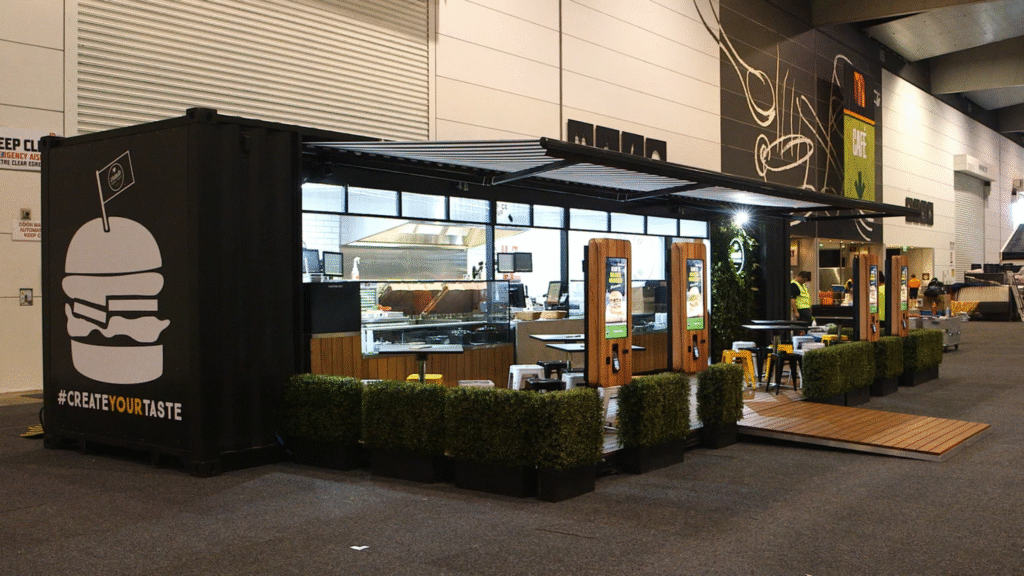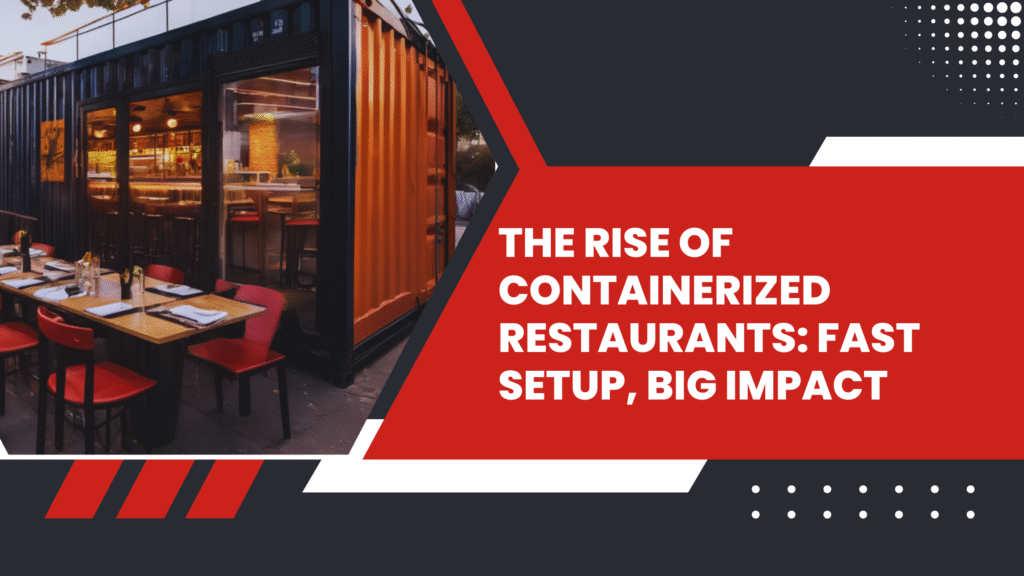With the world embracing innovative ways for restaurant design, it is not surprising that many in the UAE are adopting modular restaurant designs. Do containerised restaurants in the UAE offer any benefits? If yes, then how? This is what anyone interested in starting a restaurant in the UAE will ask.
For many, the answer lies in portacabin rental in the UAE, which makes it easy to launch a restaurant with reduced setup time, lower costs, and flexible expansion options.
So, let us answer these questions for you in this article.

Why Containerized Restaurants in the UAE Are Booming
There are many different reasons for the sudden boom of containerized restaurants in the UAE. Some of the major factors of this aspect are:
1. Speed of Setup & Mobility
Unlike brick-and-mortar kitchens, which require months of construction and permits, container kitchens can be set up in a matter of days. These shipping container kitchens are already furnished with HVAC, LED lighting, grease traps, and water systems.
Businesses that need to quickly adapt, for festivals, food parks, or seasonal demand spikes, are supported by the UAE’s modular restaurant setup.
2. Lower Capital & Operational Costs
Container kitchens in Dubai and elsewhere need less initial capital than renting or constructing entire restaurants. Companies such as Emirates Portacabin and Portacabin Express can retrofit containers with cost-effective kitchen equipment.
Food entrepreneurs are able to enter the market with less financial risk thanks to this economic approach.
3. Branding & Design Flexibility
Brands can create a powerful visual identity with a custom container restaurant design. In the UAE, movable branding façades, color schemes, and lighting packages that draw foot traffic are made possible by modified containers.
Younger audiences are drawn to container architecture because of its urban aesthetic and Instagrammable appeal.
Types of Containers You Might Need for a Restaurant
There are many different types of containers you will find when discussing the needs of your place with manufacturers.
The ones that suit most for containerized restaurants in UAE are:
1. Modified Containers in the UAE
These are typical ISO steel shipping units that have been renovated with stainless steel surfaces, ventilation, plumbing, and electrical systems specifically designed for kitchen use, as well as internal insulation.
The entire container is designed to be energy-efficient, hygienic, and fire-safe.
2. Light Gauge Steel
Light-gauge steel is frequently used to construct support structures, shelving, and mezzanines because it is strong and lightweight. Secure integration into containerized restaurant modules is made possible by light-gauge steel manufacturers that specialize in modular steel building components.
Operational & Business Advantages of Porta Cabin for Restaurants
Other than the benefits like fast setup and cost effectiveness, these shipping containers also offer functional and design features that benefit you:
1. Shipping Container Kitchen: A Fully Self‑Contained Unit
These plug-and-play units include kitchen appliances, air conditioning, lighting, and occasionally onboard generators and wastewater systems. Because of this, container kitchens in Dubai are a great option for isolated or transient spaces.
2. Modular Restaurant Setup UAE: Scalable and Flexible
Starting with a single container kiosk, operators can grow to multi-unit food courts or modular setups that include a kitchen, storage, seating, and a dine-in area. This adaptability helps festivals, events, and seasonal businesses.
3. Rapid Market Entry & Reduced Downtime
A containerized approach often needs only a few weeks for fabrication and installation, whereas traditional outlets may take six months to launch. This enables business owners to test new menu items or pop-up tactics quickly.
4. Eco‑friendly & Reuse-Oriented
Many portacabin manufacturers in the UAE recycle shipping containers, which supports the sustainability objectives of the United Arab Emirates. Containerized units can be moved or reused between sites, reducing construction waste.
5. Revitalizing Under‑utilized Spaces
Container restaurants are best positioned in empty lots, gas station forecourts, or even malls with empty outdoor spaces. These modular homes can stimulate foot traffic and revitalize underutilized space.
Operational Challenges & Regulatory Considerations
Permitting may be less complicated than for regular construction, but local municipality regulations still apply. Even container kitchens need to deal with zoning restrictions, electrical and civil defense certifications, signage permits, and food safety approvals. Depending on the use and location, some promoters might still need official approvals.
Additionally, shipping container restaurant design still requires staffing, marketing expenditures, and utility hookups, even though setup and rental costs are lower.
Additionally, food delivery services charge high commissions (usually between 30 and 35%), which can reduce margins unless there is a lot of direct ordering or foot traffic based on location.
Market Sectors & Use Cases for Shipping Containers in the Food Industry
So, how can you use these containers in the food industry? Here are the best ideas:
1. Street‑food Pop‑ups & Touristic Zones
In order to attract both tourists and locals, Dubai has seen container-based kiosks in beach areas, shopping malls, and festival grounds that serve grilled foods, drinks, and dessert ideas.
2. Cloud Kitchens & Ghost‑Kitchen Hybrid Models
Certain container kitchens function as “ghost kitchens,” preparing food exclusively for delivery platforms. Multibrand operations without storefront seating are made possible by these modular facilities, which can be arranged in parks or clusters.
3. Event & Festival Catering
Festivals and trade shows frequently use container restaurants, such as food trucks or booths, to ensure brand consistency, rapid demobilization, and effective vendor integration.
4. Corporate or Mall Extensions
During significant renovations or expansions in shopping centers and corporate campuses, containerized units are utilized as annex cafés or kiosk extensions, providing minimal disruption and ensuring revenue continuity.
Conclusion
Containerized restaurants are redefining the food industry in the UAE, offering unmatched speed, flexibility, and design freedom.
From pop-up stalls to full-scale modular dining units, they allow entrepreneurs to enter the market with lower investment and greater agility. Leading container manufacturing companies in the UAE, like Emirates Porta Cabin UAE, provide fully equipped, customizable units that meet safety, hygiene, and aesthetic standards.
Whether you’re launching a new concept or expanding operations, container kitchens offer a smart, scalable solution. With the growing demand for unique dining experiences, now is the perfect time to consider going modular in the UAE’s thriving food scene.
FAQs
What are the benefits of containerized restaurants in the UAE?
Containerized restaurants in the UAE offer faster setup, lower investment, scalability, and eco-friendly construction. They are ideal for startups, seasonal businesses, and event-based food services due to their mobility, customization, and cost-effective operation.
How much does it cost to start a container restaurant in the UAE?
Starting a container restaurant in the UAE typically costs AED 80,000 to AED 250,000, depending on size, design, and equipment. Additional costs may include permits, branding, kitchen appliances, and utilities, making it a flexible yet affordable business model.

